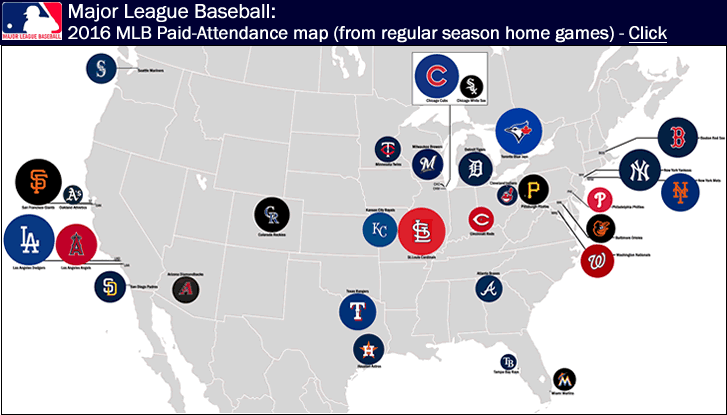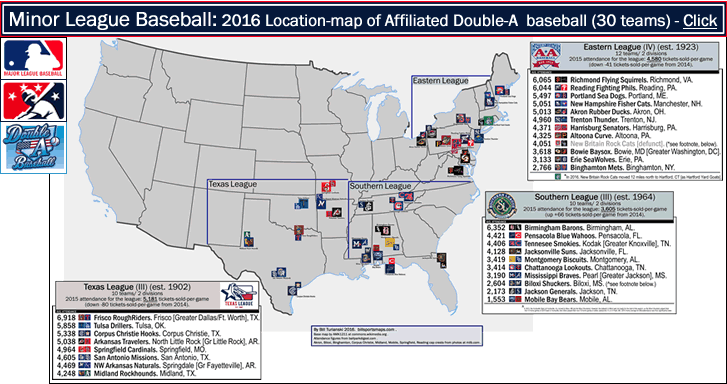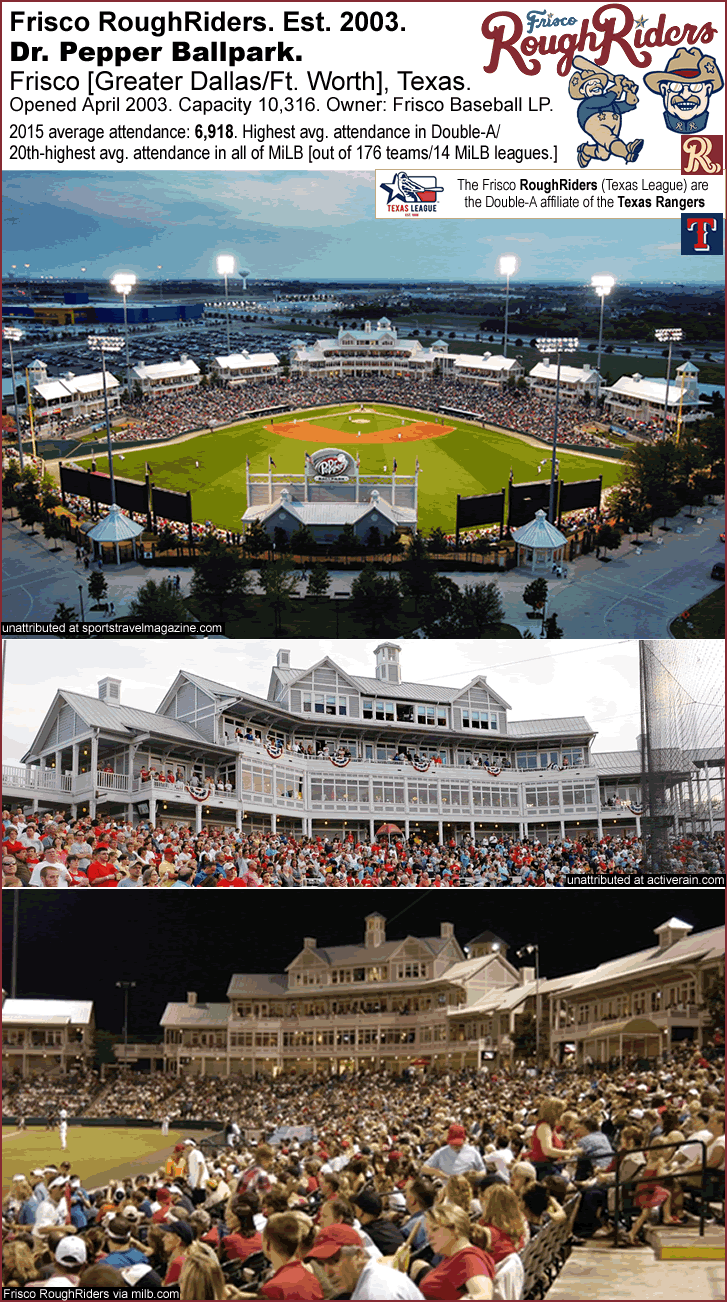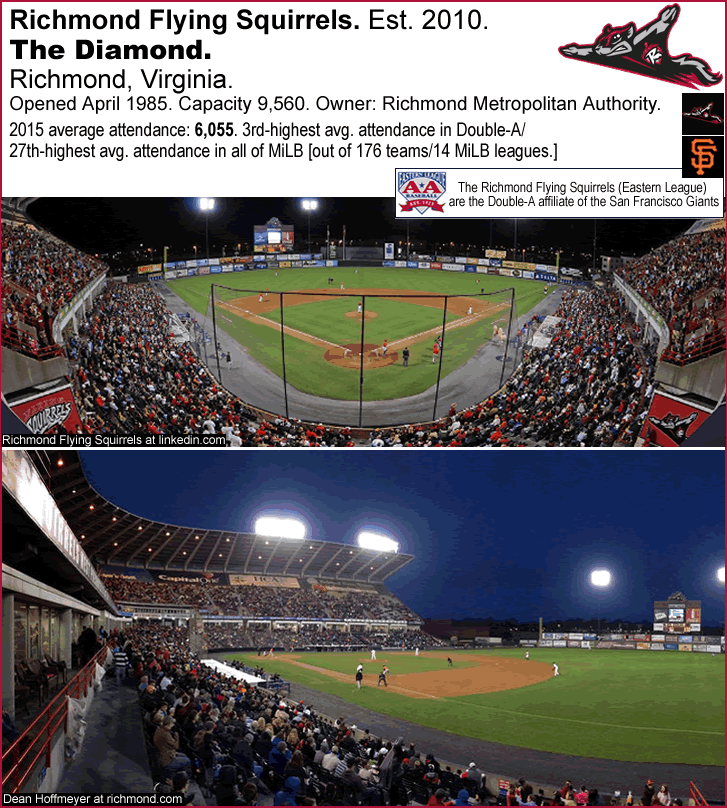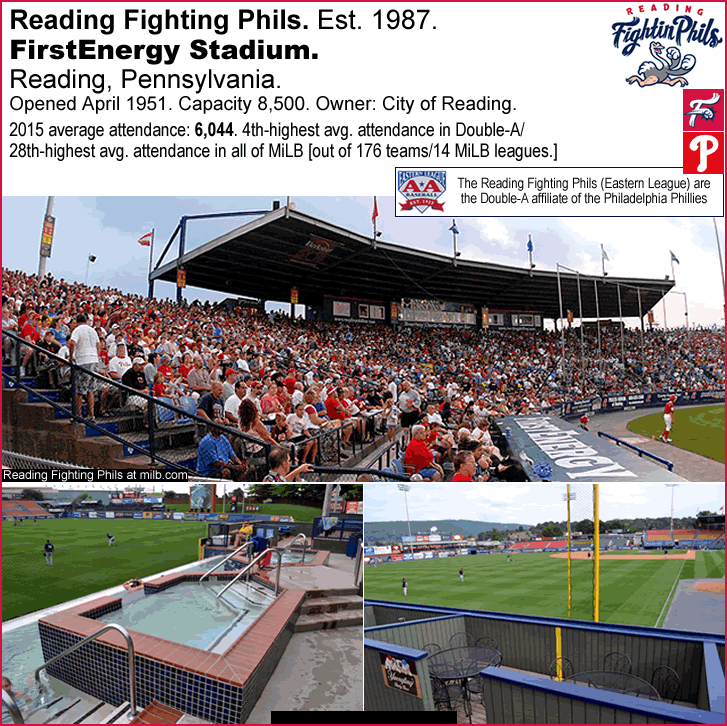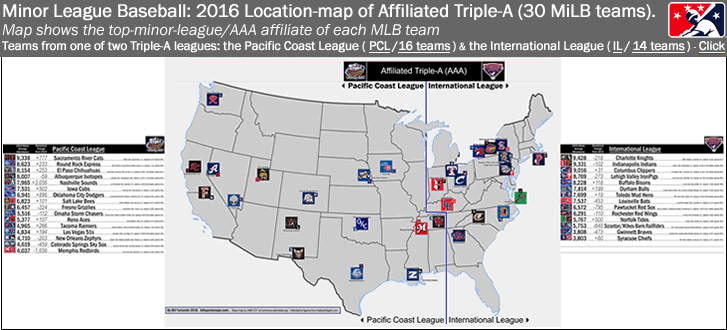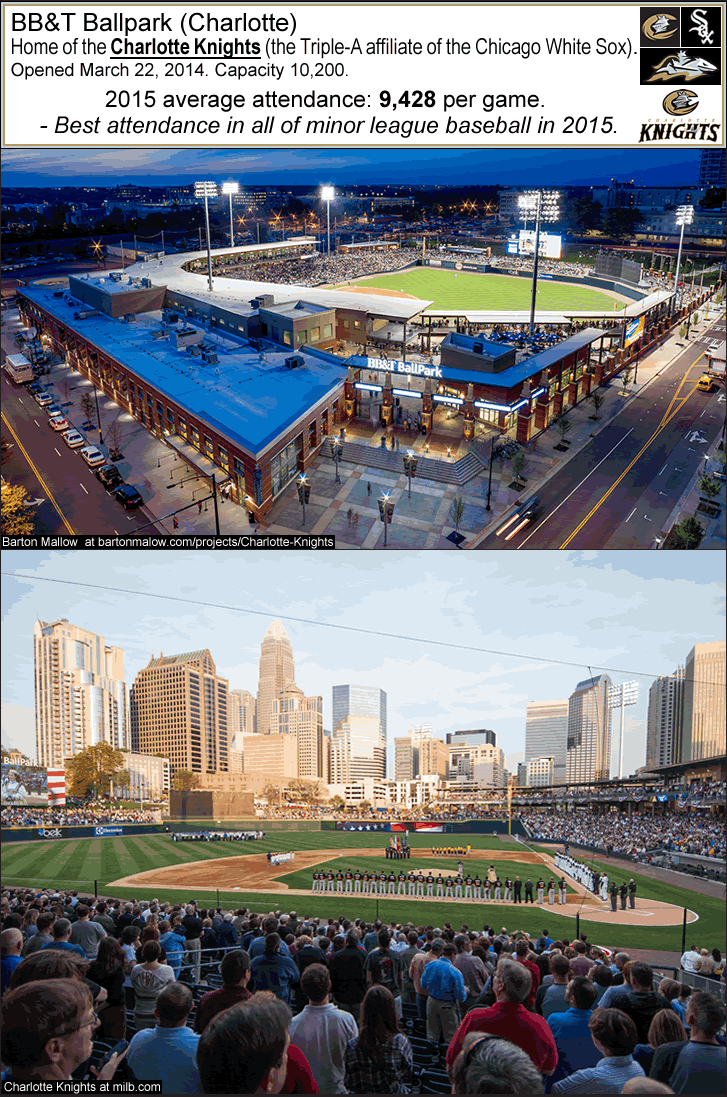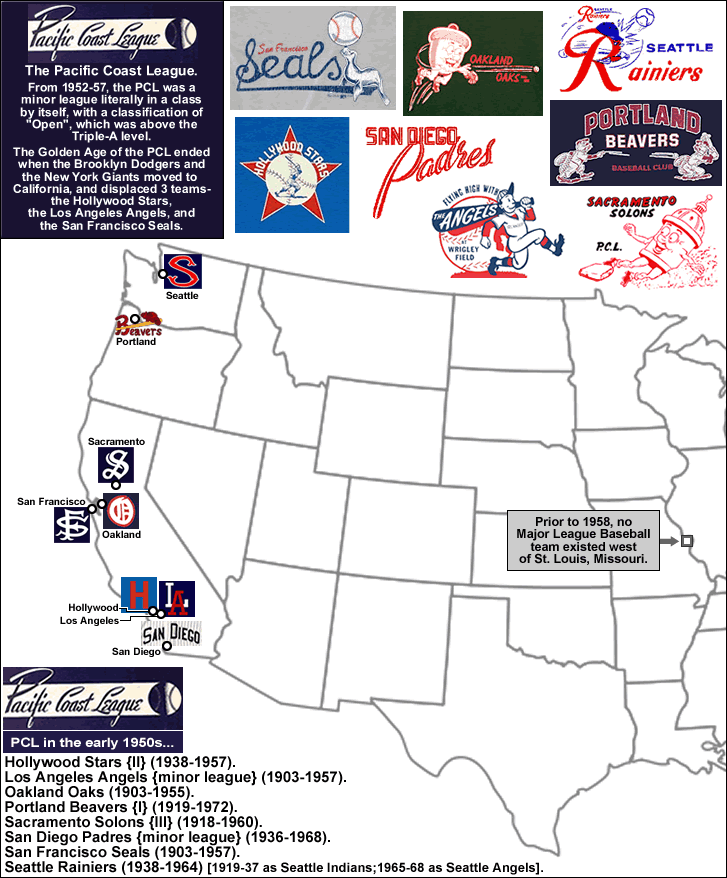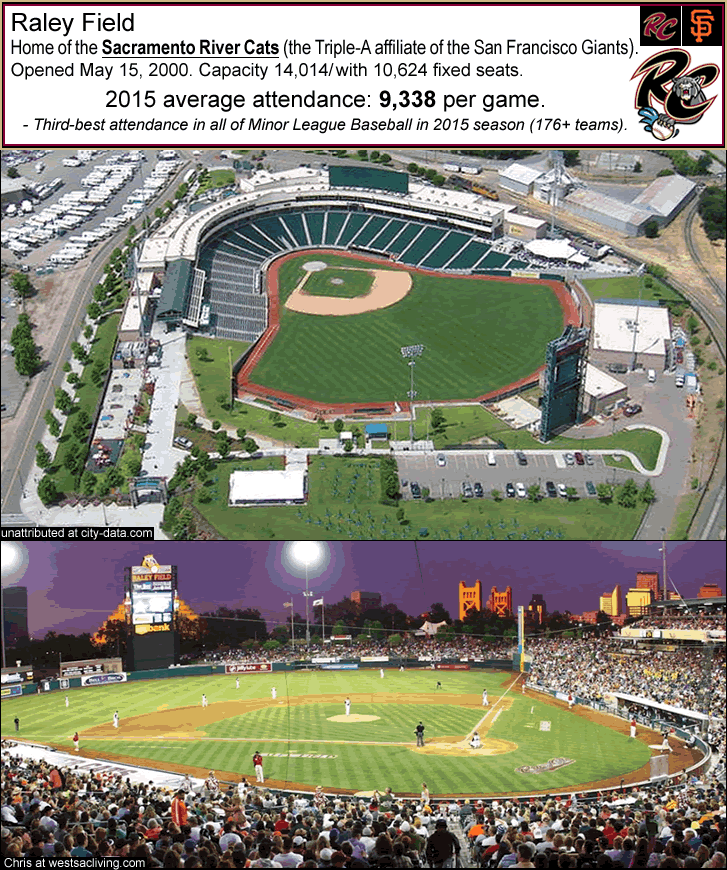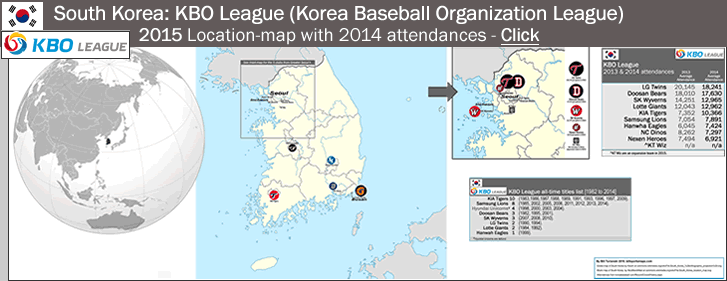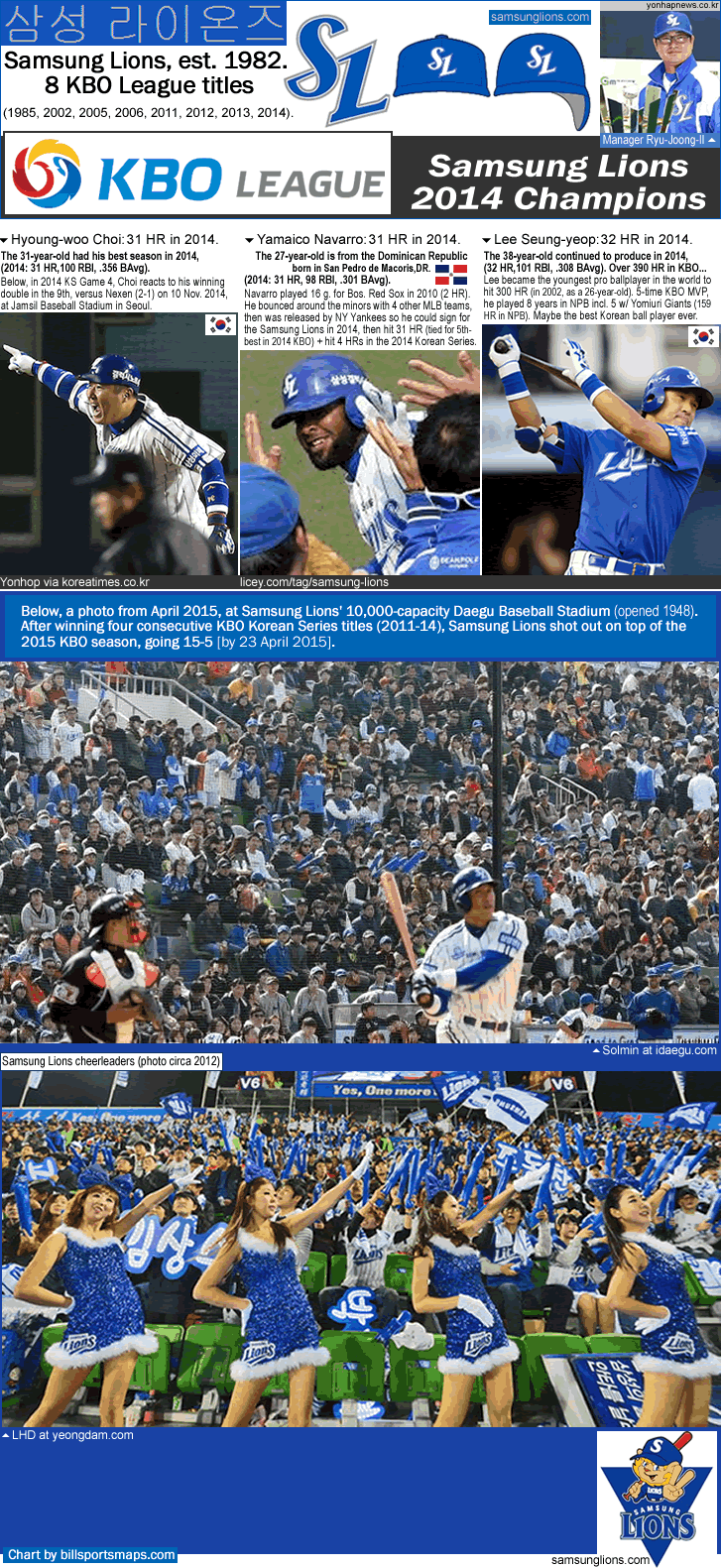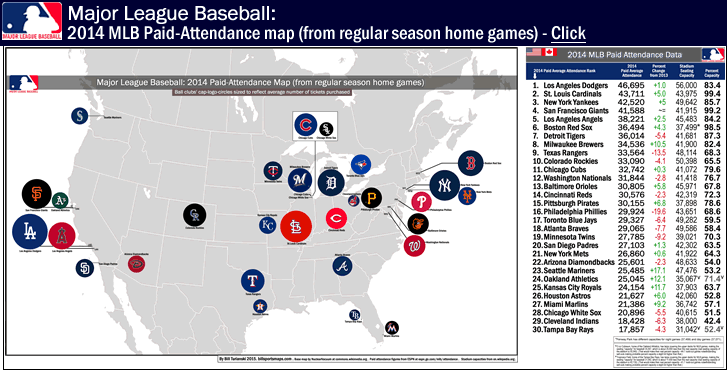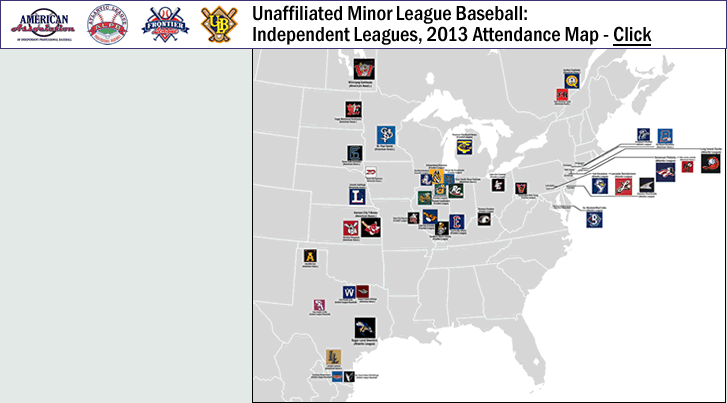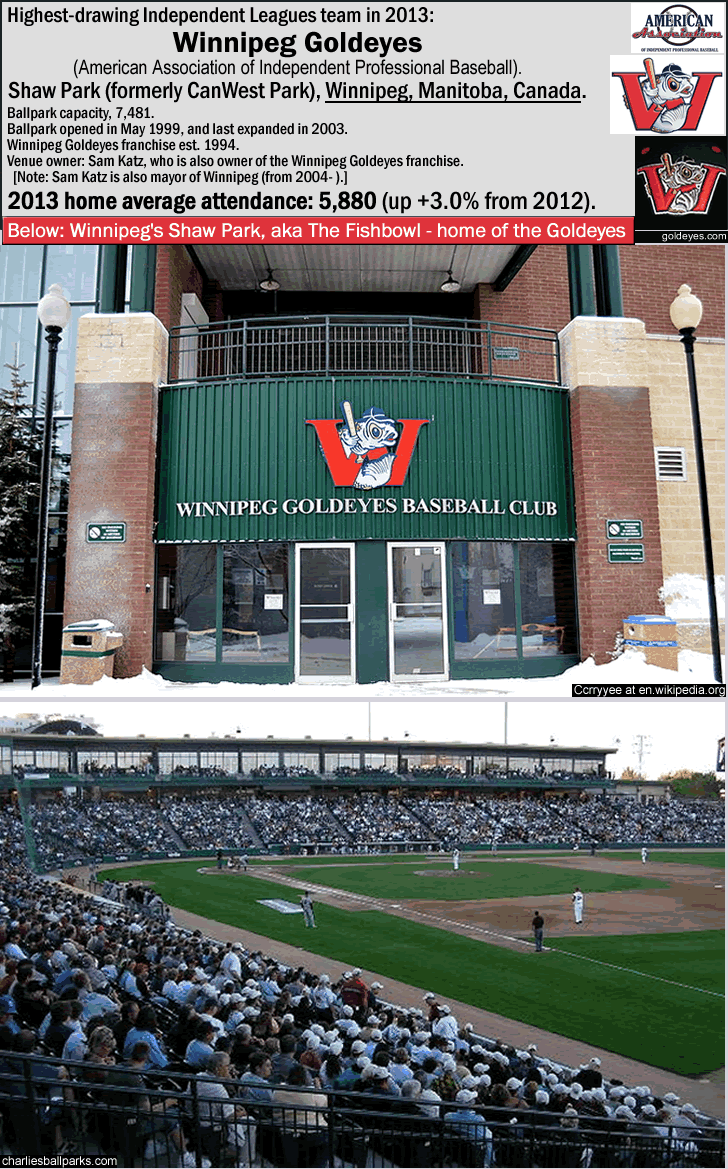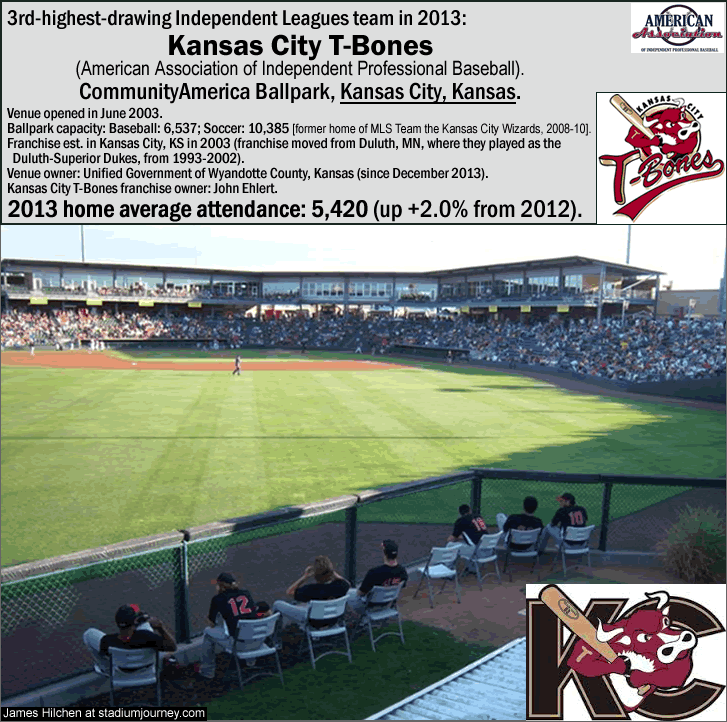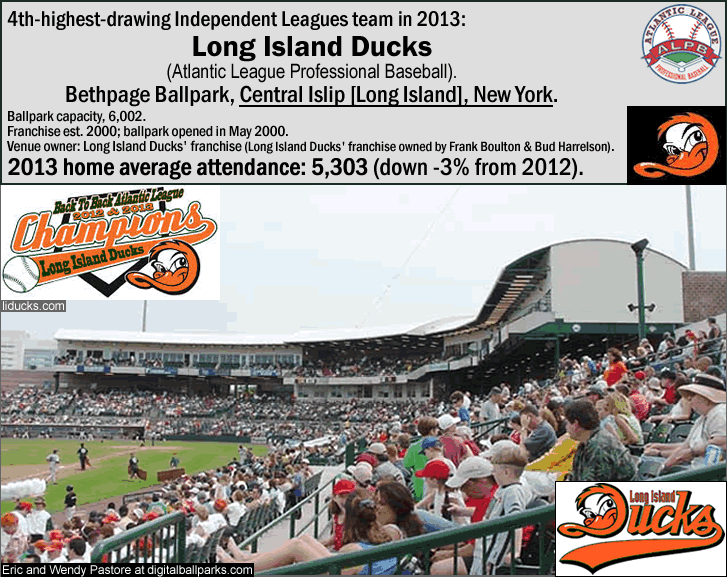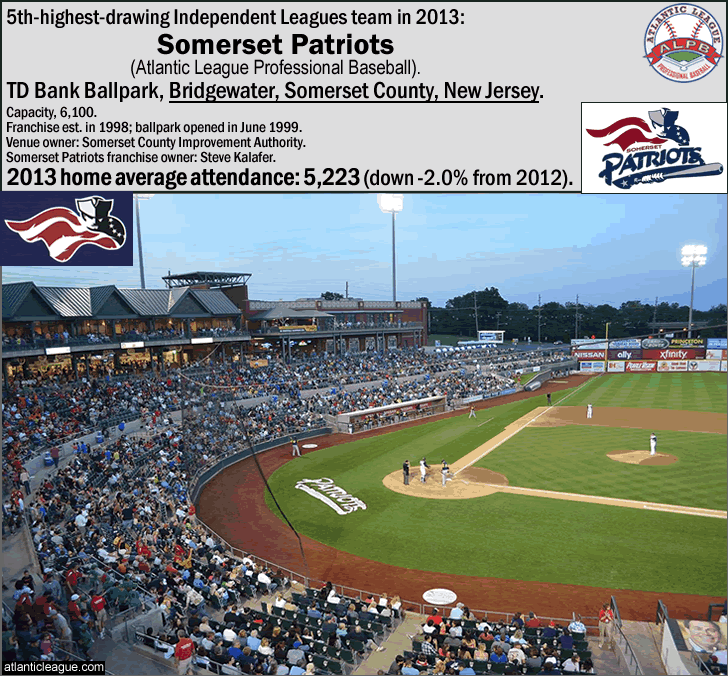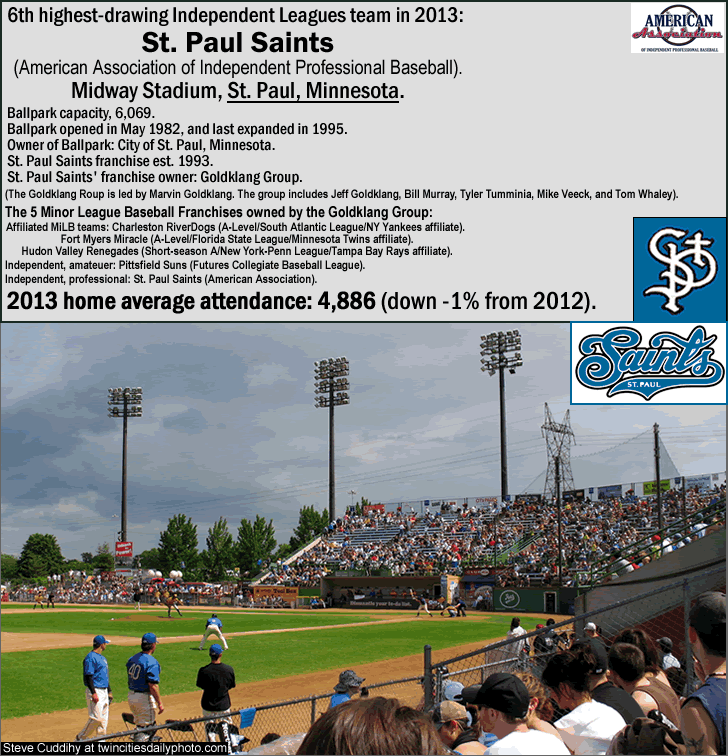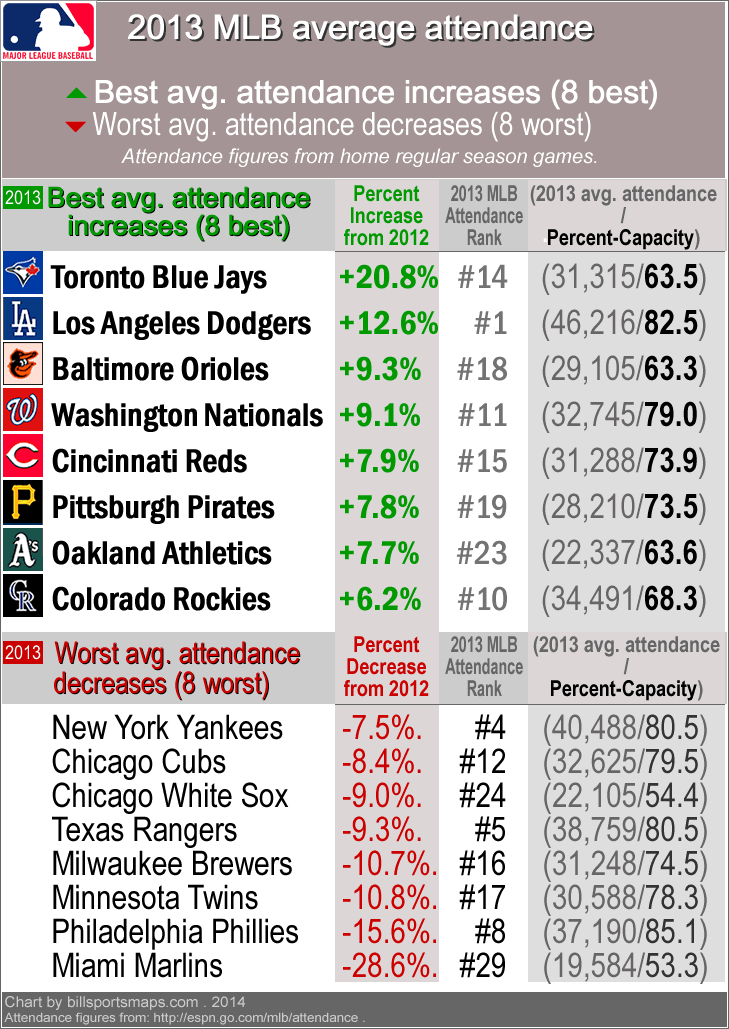
Minor League Baseball: 2013 attendance map, 84 highest drawing teams
…
…
Attendance figures on the map (source)
From Ballparkdigest.com, from Sept. 16 2013, ‘2013 Baseball Attendance by Average [Minor Leagues]‘ (ballparkdigest.com).
From en.wikipedia, ‘Minor League Baseball/ Current system‘
& ‘Independent baseball league/ Current leagues‘.
Below is an overview of Affiliated MiLB, its levels, and its relationship to the Independent leagues (or lack thereof)
Affiliated Minor League Baseball is comprised of 18 of the 19 leagues in Organized Baseball
(MiLB is an informal quasi-acronym for minor league baseball.)
Affiliated means that the minor league ball club, though being a separate entity (a separate franchise), has a player-development working agreement (a PDC) with one of the 30 Major League Baseball clubs. An affiliated MiLB team, in other words, is under the protective umbrella of Major League Baseball. I say protective, because, crucially, the MLB team provides players and coaching staff to the MiLB team, and pays their salaries. Affiliated MiLB teams are within a ladder-arrangement on, officially, 4 levels which are below Major League Baseball. But, for all intents and purposes, there really are 6 minor league levels below the Major Leagues (see 2 paragraphs below). Organized Baseball is comprised of the 30 Major League Baseball teams and all their minor league affiliates which are in the 18 MiLB leagues, plus one other league, the Mexican League, which has 16 unaffiliated teams [official name of the Mexican League is Liga Mexicana de Béisbol]. (Note: each MLB team has 7 or 8 minor league affiliates; for example, here are the Boston Red Sox’ farm teams, ‘en.wikipedia.org/wiki/Boston_Red_Sox#Minor_league_affiliations‘)
There are affiliated MiLB teams in the United States, Canada, the Dominican Republic, and Venezuela, but outside of the Vancouver Canadians (an A-level ball club), all the affiliated MiLB teams above the Rookie leagues are in the USA. (As the name implies, Rookie leagues players are straight out of high school, and by signing with an MLB team, have turned pro.) The MiLB teams themselves never move up or down the leagues-ladder via on-field accomplishments (as with teams in football [soccer] leagues or in rugby leagues in other parts of the world), but once in a while, MiLB franchises can move up or down a level or so (as with the case of the Durham Bulls franchise of Durham, North Carolina, which moved up 3 levels from Class-A to Triple-A in 1998). But the crucial factor (indeed, the whole raison d’être for Organized Baseball’s minor leagues) is, of course, that minor league players themselves can and do move up the ladder all the way to the big leagues, if they have what it takes to play in The Show (the Major Leagues).
The 4 different types of minor league ball clubs:
1). Affiliated teams in Organized Baseball.
2). Unaffiliated teams in Organized Baseball [Mexican Triple-A teams].
3). Independent leagues teams.
4). Summer collegiate baseball teams [amateur teams].
There are 4 types of minor league baseball teams. Two of these types are within the set-up of Organized Baseball. The affiliated teams come from 18 minor leagues spread out within the 4 levels, which are, going from highest-placed-level to the lowest-placed-level…Triple-A (aka AAA), Double-A (AA), Single-A (A-level/see following sentence for further description), and the Rookie leagues. But actually there are really 6 levels in affiliated MiLB, because the A-level is split into three levels of its own…Advanced-A, Class-A, and short season-A (and short season-A teams are from generally speaking, much smaller cities than adv-A or A-Class cities, and are stocked with many Rookie leagues-caliber players, and play in a season about only 50% as long as higher-placed MiLB leagues. The NY-Penn League and the Northwest League, which are the 2 short season-A leagues, don’t start their seasons until June.
The other two types of minor league ball clubs are the teams from the Independent leagues, and the teams from the summer-collegiate leagues. Both are not connected in any way with Major League Baseball (although Independent leagues teams can sell players to MLB teams). Independent leagues have sprung up in the last two decades, and there are currently [2014] 7 Independent leagues, two of which have teams which draw well enough to have made this map (see 5 paragraphs below). With Independent leagues teams, while there there is a greater chance of financial failure, there is also a wrinkle in MLB/MiLB/Organized Baseball rules which has inadvertently allowed some Independent leagues teams to do very well at the turnstiles (also see 5 paragraphs below). The basic reason why it is much harder for Independent leagues teams to succeed financially is the simple fact that these teams from the ‘outlaw’ leagues must pay salaries to their coaching staff and their players (and some times build their own ballparks), while MiLB teams within Organized Baseball have the safety net of having their coaching staff and players’ salaries paid for by their parent-club (ie, the Major League team which they are affiliated with). Finally there are the summer-collegiate leagues (see 6 paragraphs below).
Attendance measurement within Organized Baseball’s minor leagues & within other MiLB leagues
Of the 19 minor leagues within Organized Baseball, 15 measure paid attendance – all 3 of the Triple-A leagues, all 3 Double-A leagues, all 7 A-level leagues, and 2 of the 6 Rookie leagues also do: the Pioneer League of the central Rocky Mountains, and the Appalachian League of the southern Appalachian Mountains and Piedmont region. The other 4 Rookie leagues do not measure attendance (those are the Arizona League, the Gulf Coast League [in Florida], the Dominican Summer League, and the Venezuelan League). The attendance measurement within the Independent leagues and within the collegiate summer leagues is way more hit-or-miss, and some of the Independent leagues don’t publish their attendances (because they are so low I am guessing). Also, some collegiate summer league teams inflate their attendance figures {see this from Ballparksdigest.com/3rd paragraph there} (so it is probably just as well that I decided to draw the line where I did with respect to crowd-sizes on the map).
…
I made a map of the 122-highest-drawing minor league baseball team 2 years ago {here, ‘Minor League Baseball – Top 122 drawing teams within Organized Baseball and in the Independent Leagues – all teams that drew over 3,000 per game in 2011‘ (billsportsmaps.com).
…
Map of 84 highest-drawing MiLB teams in 2013
This time, I decided to narrow the focus to about three-quarters of that, to all minor league baseball teams in North America which drew over 4,000 per game in 2013 (instead of all minor league teams which drew over 3,000 per game). So the map here shows the top 84-drawing minor league teams in North America from the 2013 season (from home/regular season games). On the map there ended up being 76 MiLB teams within Organized Baseball (68 of them being affiliated with one of the 30 MLB teams as farm clubs, and 8 being from the Mexican League [which, as mentioned before, is part of the Organized Baseball set-up but whose teams are franchises which have no affiliation with any MLB teams - and in fact have minor league farm clubs of their own]).
The 76 Organized Baseball/MiLB teams on the map
The horizontal bar at the top of the map page lists every Organized Baseball/MiLB team in levels 2 through 6 (see immediately below for description of Organized Baseball/MiLB levels), with the 76 Organized Baseball/MiLB teams on the map in bold type (with 2013 attendance rank), as well listing as all the other Organized Baseball/MiLB teams above the Rookie leagues which drew too low to make the map.
At the far right of the map page, the attendance list includes a column for which level the MiLB teams are in, with:
level 1 being MLB (ie, there are no level 1/MLB teams on the map because this is a map of minor league teams),
level 2 being Triple-A,
level 3 being Double-A,
level 4 being advanced-A,
level 5 being Class-A,
level 6 being short-season-A
(note: no level 7 or Rookie leagues teams made the map).
The 8 Mexican League teams on the map
The 8 Mexican League teams on the map include the highest-drawing minor league ball club in all of North America last year – the Sultanes de Monterrey, of Monterrey, Nuevo León. The seven other Mexican League teams on the map are: Saraperos de Saltillo (the Saltillo Serape Makers), Acereros de Monclova (the Monclova Steelers), Diablos Rojos del México (the Mexico [City] Red Devils), Delfines del Ciudad Carmen (the Carmen City Dolphins), Pericos de Puebla (the Puebla Parrots), Vaqueros Laguna (the Laguna Cowboys), and Leones de Yucatán (the Yucatan Lions). The Mexican League has 16 teams; here is their page on en.wikipedia.org, ‘Mexican League‘.]
The 7 Independent leagues teams on the map, and the ability of Independent leagues teams to circumvent the 75-mile-radius protected-market territory which MLB allows each MLB team to enforce within Organized Baseball [via MLB's anti-trust exemption]
As far as representation from the Independent Leagues – on the map there ended up being 7 teams which are from the Independent leagues. Although they can and do develop players who they then sell to Major League teams, the Independent leagues have no formal connection with Organized Baseball. Thus they are able to place franchises in areas that Organized Baseball has zones of exclusion, or protected territory. Such as in south-east-central Pennsylvania, where Organized Baseball protects the MLB team the Philadelphia Phillies as well as the affiliated MiLB teams the Reading Fightin’ Phils and the Harrisburg Senators from there being any other Organized Baseball/MiLB teams in that region, but where the Independent league team the Lancaster Barnstormers (and the York Revolution) ignore that monopolistic edict and flourish. Also as with the case on Long Island, New York in Nassau and Suffolk counties, where MLB protects the New York Mets (as well as the New York Yankees) from there being any Organized Baseball/MiLB team in that region, but where the Independent leagues team the Long Island Ducks ignore that monopolistic edict and flourish. And also as with the cases of the Kansas City T-Bones and the Sugar Land [Houston] Skeeters, among others.
The 7 Independent leagues teams on the map –
[Note: here is my Independent leagues attendance map, which I posted earlier in 2014 (please note that some of the text there has been repeated here, below), http://billsportsmaps.com/?p=26979 .
-The Winnipeg Goldeyes [of the American Association] (from Winnipeg, Manitoba, Canada, and the only Canadian team on the map besides the Vancouver Canadians).
-The Sugar Land Skeeters [of the Atlantic League] (from the west side of Greater Houston, Texas).
-The Kansas City T-Bones [of the American Association] (from the Kansas side of Greater Kansas City, Missouri).
-The Long Island Ducks [of the Atlantic League] (from Central Islip, Long Island, New York in Suffolk County about 25 miles east of the NYC border).
-The Somerset Patriots [of the Atlantic League] (from what can be referred to as the outer western edge of Greater New York City in Bridgewater, New Jersey).
-The St. Paul Saints [of the American Association] (from the eastern half of the Twin Cities of Minneapolis/St. Paul, Minnesota).
-The Lancaster Barnstormers [of the Atlantic League] (from Lancaster, south-east-central Pennsylvania).
The American Association [of Independent Professional Baseball]
The American Association has 16 teams and is based primarily in the Upper Midwest and the Plains States from Texas to the Dakotas, plus Manitoba and Quebec in Canada, plus a few teams in the Northeast. The American Association has been around since 2006 but features some teams that have been around for over two decades (such as the St. Paul Saints). The American Association was founded by Miles Wolff in 2006. Wolff had previously been founder of the first modern-day Independent league in 1993, with the now-defunct Northern League (of 1993-2010). Here are four excerpts from that former Independent league’s page at en.wikipedia.org…’The modern Northern League was founded by Miles Wolff. Wolff started the league after many midwestern cities contacted him (through his affiliation with Baseball America) asking how they could get a minor league team. After visiting some of them, most notably Wade Stadium in Duluth, he began contacting potential owners to start the league.’/…’The league began in 1993 with 6 teams: Duluth-Superior Dukes (Duluth, Minnesota), Rochester Aces (Rochester, Minnesota), St. Paul Saints (St. Paul, Minnesota), Sioux Falls Canaries (Sioux Falls, South Dakota), Sioux City Explorers (Sioux City, Iowa) and Thunder Bay Whiskey Jacks (Thunder Bay, Ontario). The prospects for the league were originally “cloudy.” Many forecast an early demise especially in St. Paul where competition with the Minnesota Twins led many local sportswriters to consider it a “beer league.” The league, however, was a relatively moderate success, with only the Rochester franchise struggling to draw crowds to their games.’/…’ Following the [2005] season’s conclusion St. Paul, Sioux City, Sioux Falls, and Lincoln announced they were leaving the league to form a new independent league with five teams from the folded Central Baseball League in the southern United States; the new league was to be known as the American Association of Independent Professional Baseball.’/…’Following the 2010 season, the Northern League announced that Winnipeg, Kansas City, Fargo-Moorhead, and Gary SouthShore would be leaving the league to join the American Association’ …{end of excerpts}. The Northern League folded in 2010, but its legacy and 3 of its founding teams and 5 more of its expansion teams still exist today as 8 of the 16 franchises in the American Association (the 3 founding teams of the Northern League [1993-2010] which still exist today in the American Association are the St. Pauls Saints, the Sioux City Explorers, and the Sioux Falls Canaries). Miles Wolff, the founder of the influential publication Baseball America, and the modern-day creator of the Independent league-model, was commissioner of the trailblazing Northern League from 1993 to 2002. Wolff is presently commissioner of the American Association (which is headquartered in Durham, NC). Wolff also owns the American Association team the Québec Capitales (of Quebec City, Quebec, Canada), as well as the collegiate summer league team the Elmira Pioneers. Here is the American Association of Independent Professional Baseball’s page at en.wikipedia.org, ‘American Association of Independent Professional Baseball‘.
There is one American Association team that owns its ballpark, the highest-drawing Independent leagues team, the Winnipeg Goldeyes, who play at Shaw Park. Shaw Park, which opened in 1999 and has been expanded twice since, has a capacity of 7,481. It is owned by Sam Katz, owner of the Goldeyes, and, since 2004, the mayor of Winnipeg, Manitoba. Katz, the first Jewish mayor of Manitoba, is in his third term.
Atlantic League [Professional Baseball],
The Atlantic League has 8 teams in their league. The Atlantic League has 7 teams in the Northeast and one team in Greater Houston, Texas. The league will soon expand to two locations in Virginia (probably in 2016/ see this post from the Indepenent Baseball.net site, http://www.independentbaseball.net/independent-baseball-teams/midoctober-recap-independent-pro-baseball-industry/), adding one new team in northern Virginia in Greater Washington DC [the Loudon Hounds of Ashburn, VA]; and one new team in SE coastal Virginia near Norfolk [the Virginia Beach Neptunes of Virginia Beach, VA]. It might interest you to know that Baseball Hall of Famer/Baltimore Orioles third baseman Brooks Robinson (in a consortium named Opening Day Partners) is a co-owner of the Lancaster team & the York team and the Texas team (and 2 other franchises in the Atlantic League). The NY Mets fan favorite, mercurial Shortstop Bud Harrelson, is a co-owner of the Long Island team. Harrelson co-owns the Long Island Ducks with Long Island-native Frank Boulton, who used to own the now-defunct Albany, NY Eastern League franchise, then tried to set up a Long Island-based team still within the Organized Baseball umbrella, but was blocked by MLB and the New York Mets from doing so, then set up the Independent league in 1998. 2 years later, Boulton and the Atlantic League put a franchise in Suffolk County, Long Island, NY, with the Mets powerless to stop him. Boulton thumbed his nose at MLB and built the 6 K-capacity Bethpage Ballpark in 2000, where the Ducks pack ‘em in to this day, setting a consecutive-sellout-record for MiLB along the way. Here is what it says about all that at the Atlantic League‘s page at en.wikipedia.org, {excerpt}…’The creation of the league was the result of the New York Mets’ objection to Frank Boulton’s proposal to move the former Albany-Colonie Yankees because of its territorial rights to the region. Boulton, a Long Island native, decided to create a new league that would have a higher salary cap for its players and a longer season than most of the other independent baseball organizations. He modeled the Atlantic League after the older Pacific Coast League, with facilities that exceed AAA-level standards. Boulton also emphasized signing players of Major League Baseball experience for all Atlantic League teams, raising the level of play above other independent leagues.’…{end of excerpt}.
The Long Island Ducks are one of three Atlantic League teams which own and operate the ballparks they play in (the other two are the Sugar Land Skeeters, and the soon-to-be-expansion team the Loudon Hounds of northern Virginia).
The only amateur team on the map, the Madison Mallards
Finally, there is one amateur team on the map – the Madison Mallards. They are in the Northwoods League, which is one of many collegiate summer baseball leagues in the US. The collegiate ballplayers on these teams only receive a room and board stipend (as mentioned before, all the rest of the teams on the map are from leagues which are professional – and that includes the teams from the Independent leagues). In places such as Cope Cod in Massachusetts and in Alaska and in New England and in Upstate New York and in Wisconsin/Minnesota/Iowa/western Ontario, Canada and in the South Atlantic (as well as several other regions), there are leagues such as this. Actually there are quite a lot of these leagues {see this, ‘List of collegiate summer baseball leagues‘}. With one exception, the summer-collegiate leagues teams do not draw above 3,000 per game, but it must be pointed out that attendances in the collegiate summer leagues have been steadily improving in the last few years. In 2013, there were 7 collegiate summer league teams that drew over 2,000 per game, out of 144 teams from the 14 primary summer-collegiate leagues/{see this from Ballparkdigest.com, ‘2013 Summer-Collegiate Attendance by League‘}. The exception is the Madison Mallards, of Madison, Wisconsin (a city which lost its A-level affiliated minor league team after the 1994 season). The Mallards drew an astounding 6,100 per game in 2013. Think about it – 6K per game of ticket-paying public…and no players’ salaries to pay. Talk about a sweet deal for the Mallards’ owners. Why MLB has not put an MiLB team back in Madison, Wisconsin is an absolute mystery to me.
What the map shows
Below is a list of all minor leagues which measure attendance. The total number teams in the league drawing above 4K per game in 2013 (ie, teams on the map here) are listed in bold type.
Below: List of 2013 MiLB attendance by league (the list includes all 15 MiLB leagues within Organized Baseball which measure attendance plus the top 2-drawing Independent leagues)
List below is ranked in order of highest-to-lowest-drawing, with affiliated-MiLB levels noted, and with season length noted [knowing that total games in season divided by 2 equals the number of home games per team].
(Note: at the top horizontal bar above the map on the map page, these league-average-attendance figures are also shown, but here they are shown from highest to lowest league-average.)
(Please also note: level 1=Major League Baseball {not listed here}; Mexican League is at level 2, but with its teams being unaffiliated; while Independent leagues level is n/a but is probably equivalent to Double-A or level 3-caliber.)
#1, International League (Triple-A/ level/ 2 / 14 teams/ 144 game regular season), 7,041 per game. 13 of 14 teams drew above 4K per game in 2013.
#2, Pacific Coast League (Triple-A/ level 2 / 16 teams/ 144 game regular season), 6,053 per game. 15 of 16 teams drew above 4K per game in 2013.
#3, Texas League (Double-A/ level 3 / 8 teams/ 140 game regular season), 5,377 per game. All 8 teams teams drew above 4K per game in 2013.
#4, Eastern League (Double-A / level 3 / 14 teams/ 142 game regular season), 4,616 per game. 8 of 12 teams drew above 4K per game in 2013.
#5, Mexican League (Triple-A, but unaffiliated) / level 2 / 16 teams/ 114 game regular season), 4,519 per game. 8 of 16 teams drew above 4K per game in 2013.
#6, Atlantic League Pro Baseball (Independent league/ level: n/a / 8 teams/ 140 game regular season), 4,152 per game. 4 of 8 teams drew above 4K per game in 2013.
#7, Midwest League (Class-A/ level 5 / 16 teams/ 140 game regular season), 3,907 per game. 5 of 16 teams drew above 4K per game in 2013.
#8, Carolina League (Advanced-A/ level 4 / 8 teams/ 140 game regular season), 3,657 per game. 3 of 8 teams drew above 4K per game in 2013.
#9, Southern League (Double-A/ level 3 / 10 teams/ 140 game season), 3,515 per game. 3 of 10 teams drew above 4K per game in 2013.
#10, American Association of Independent Pro Baseball (Independent league/ level: n/a / 13 teams / 100 game regular season), 3,435 per game. 3 of 13 teams drew above 4K per game in 2013.
#11, Northwest League (Short season-A/ level 6 / 8 teams/ 76 game regular season), 3,292 per game. 2 of 8 teams drew above 4K per game in 2013.
#12, South Atlantic League (Class-A)/ level 5 / 14 teams/ 140 game regular season), 3,262 per game. 5 of 14 teams drew above 4K per game in 2013.
#13, New York-Penn League (Short season-A/ level 6 / 14 teams/ 74 game regular season), 3,173 per game. 5 of 14 teams drew above 4K per game in 2013.
#14, Pioneer League (Rookie)/ level 7 / 8 teams/ 76 game regular season), 2,282 per game. Zero teams drew above 4K per game in 2013.
#15, California League (Advanced-A/ level 4 / 10 teams/ 140 game regular season), 2,275 per game. Zero teams drew above 4K per game in 2013.
#16, Florida State League (Advanced-A/ level 4 / 12 teams/ 140 game regular season) 1,606 per game. Zero teams drew above 4K per game in 2013.
#17, Appalachian League (Rookie)/ level 7 / 10 teams/ 68 game regular season), 894 per game. Zero teams drew above 4K per game in 2013.
-Data for above list at ballparkdigest.com/2013-affiliated-attendance-by-league;
and at ballparkdigest.com/2013-independent-attendance-by-league.
…
Below are illustrated profiles of the top two drawing minor league baseball teams in 2013 – the unaffiliated MiLB team Sultanes de Monterrey, of Monterrey, Nuevo León, Mexico (from the Triple-A Mexican League); and the Columbus Clippers, of Columbus, Ohio (the top affiliated ball club of the Cleveland Indians, from the Triple-A International League).
Below: Estadio de Béisbol Monterrey,the largest ballpark in Mexico, and, for the second straight season, the home of the highest-drawing minor league ball club in North America, Sultanes de Monterrey…
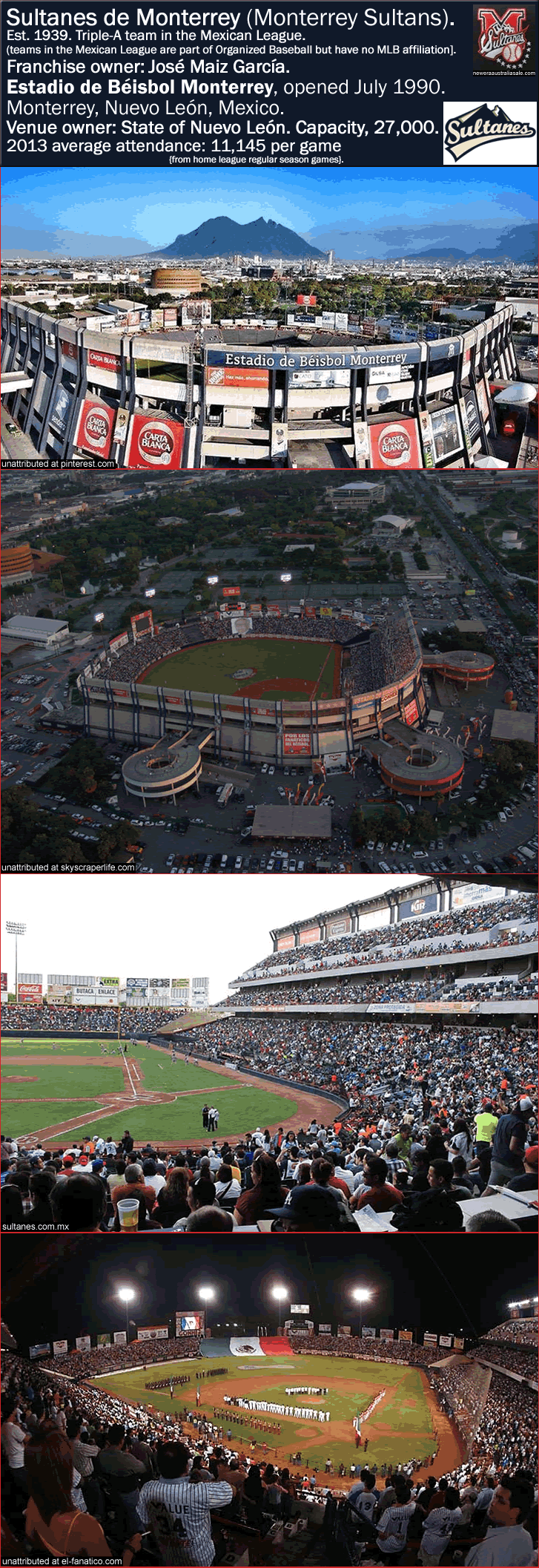
Photo credits for Estadio de Béisbol Monterrey above -
Sultanes cap logo, photo from neweraaustraliasale.com/sultanes-de-monterrey-new-era-snapback-navyred.
Exterior photo, unattributed (uploaded by Jakovo Mtz)at pinterest.com
Aerial photo, unattributed (uploaded by PUMAS AJV) at skyscraperlife.com.
Interior/day-time photo, from sultanes.com.mx.
Interior/night-time photo, unattributed at el-fanatico.com.
…
Below: Huntington Park, home of the Columbus Clippers…

Photo credits for Huntington Park (Columbus, OH) above -
Exterior, northbankcondos.com/overview/photovideogallery
Left Field Building, scolinssportsvenuesvisited.blogspot.com/2013/05/122-huntington-park-columbus-oh
Right Field Stands, Tom Reed at cleveland.oh.us/wmv_news/tomreed44.htm.
Panorama, dispatch.com/clippers.
___
Photo credits on map page,
Lexington Legends cap logo, photo from lexington.milbstore.com.
Winston-Salem Dash cap logo, photo from wsdash.milbstore.com.
Pericos de Puebla cap logo, photo from h2b.mx/products/pericos-de-puebla-mexican-pro-59fifty-cap.
Delfines de Ciudad del Carmen cap logo, photo from http://photos-c.ak.fbcdn.net/hphotos-ak-frc3/t1.0-0/c0.90.540.360/10177312_275182789310312_2283421102371401731_n.jpg.
Long Island Ducks cap logo, photo from t20.glitnirticketing.com/ldticket/store.
Acereros del Norte cap logo from acereros.com.mx.
Winnipeg Goldeyes home cap, photo from Goldeyes’ site at http://www.goldeyes.com/shop/shop-index.
Rochester Red Wing new 2014 cap logo, illustration from milb.com/news/article ['Wings unveil brand new logos'].
Saraperos de Saltillo cap logo, photo from ecapcity.com/saraperos-de-saltillo-new-era-snapback-teal-black.
Toledo Mud Hens home cap logo, photo from strictlyfitteds.com/blog/2013/01/milb-new-eratoledo-mud-hens-fitted-baseball-cap.
Sultanes de Monterrey cap logo, photo from articulo.mercadolibre.com.mx/MLM-447192360-gorra-new-era-5950-sultanes-de-monterrey.
…
Thanks to the contributors to the pages at en.wikipedia.org, ‘Minor League Baseball‘.
Thanks very much to Ballparkdigest.com
